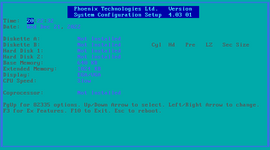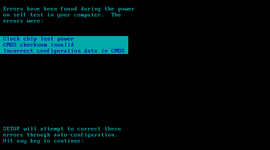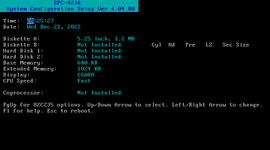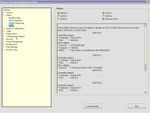No edit summary |
No edit summary |
||
| (3 intermediate revisions by the same user not shown) | |||
| Line 1: | Line 1: | ||
[[File:Phoenix ROM BIOS PLUS POST.png|thumb|The POST screen]] | [[File:Phoenix ROM BIOS PLUS POST.png|thumb|The POST screen]] | ||
Phoenix ROM BIOS PLUS is a version of [[PhoenixBIOS]] | Phoenix ROM BIOS PLUS is a version of [[PhoenixBIOS]] released in 1987 by [[Phoenix Technologies]]. It is based on the classic PhoenixBIOS codebase. It is also the first version of PhoenixBIOS to include a built-in CMOS setup utility, although this is not present in all instances. It also introduced minor changes with some POST messages and a more detailed memory test (listing both base and extended memory). | ||
It was succeeded by [[PhoenixBIOS 4.0x]] (based on the [[Quadtel BIOS]] codebase) in 1988 and [[PhoenixBIOS Ax86]] (based on the classic PhoenixBIOS codebase) in circa 1990-1991. | It was succeeded by [[PhoenixBIOS 4.0x]] (based on the [[Quadtel BIOS]] codebase) in 1988 and [[PhoenixBIOS Ax86]] (based on the classic PhoenixBIOS codebase) in circa 1990-1991. | ||
== Built-in CMOS | == Built-in CMOS setup utility == | ||
Initially, | Initially, Phoenix only offered a single default option for the CMOS setup utility. This option had two color variants: Cyan/blue and black/cyan. Other than the color scheme and some other cosmetic changes, both of these variants are functionally the same. | ||
On later instances, the [[PhoenixBIOS Ax86]] setup utility could also be seen, which is both visually and functionally different from the earlier utilities. However it is unknown if this was an official option that was later available from Phoenix or the result of an unofficial OEM modification performed by porting the Ax86 setup utility to the older ROM BIOS PLUS codebase. | On later instances, the [[PhoenixBIOS Ax86]] setup utility could also be seen, which is both visually and functionally different from the earlier utilities. However it is unknown if this was an official option that was later available from Phoenix or the result of an unofficial OEM modification performed by porting the Ax86 setup utility to the older ROM BIOS PLUS codebase. | ||
| Line 23: | Line 23: | ||
Over its lifetime, Dell has added many new features to this fork that the original ROM BIOS PLUS never had, such as Plug and Play (PnP) support, automatic storage drive detection, SATA drive support, silent boot (full-screen BIOS logo that hides messages during POST), hardware monitoring for fan speed and temperature sensors, and more. Very late instances of this version (specifically on the latest PowerEdge series of servers that use it) even support UEFI, likely with a custom add-on written to provide an appropriate API for the features needed for UEFI support. However, it is not known if this was developed solely by Dell, or if it is fully or at least partially based on a solution from Phoenix or another vendor, as UEFI is a fundamentally different standard from BIOS. In addition to new features, several custom setup utilities have been created for this version over its lifetime, as shown below. | Over its lifetime, Dell has added many new features to this fork that the original ROM BIOS PLUS never had, such as Plug and Play (PnP) support, automatic storage drive detection, SATA drive support, silent boot (full-screen BIOS logo that hides messages during POST), hardware monitoring for fan speed and temperature sensors, and more. Very late instances of this version (specifically on the latest PowerEdge series of servers that use it) even support UEFI, likely with a custom add-on written to provide an appropriate API for the features needed for UEFI support. However, it is not known if this was developed solely by Dell, or if it is fully or at least partially based on a solution from Phoenix or another vendor, as UEFI is a fundamentally different standard from BIOS. In addition to new features, several custom setup utilities have been created for this version over its lifetime, as shown below. | ||
Although this version was originally based on the standard 1988 Phoenix ROM BIOS PLUS codebase, it has evolved into a distinctly different solution due to Dell's many changes and new features, and therefore cannot be considered the same as the original version it was based on.<gallery> | Although this version was originally based on the standard 1988 Phoenix ROM BIOS PLUS codebase, it has evolved into a distinctly different solution due to Dell's many changes and new features, and therefore cannot be considered the same as the original version it was based on.<gallery widths="150" heights="150"> | ||
File:Dell silent boot.png|Silent boot (full-screen boot logo) on OptiPlex GX150 | File:Dell silent boot.png|Silent boot (full-screen boot logo) on OptiPlex GX150 | ||
File:Dell setup 1.png|Setup utility variant 1 (1990 - mid | File:Dell setup 1.png|Setup utility variant 1 (1990 - mid 2000s), as seen on the OptiPlex GXi 5166 | ||
File:Dell setup 2.png|Setup utility variant 2 (late | File:Dell setup 2.png|Setup utility variant 2 (late 1990s - 2020), as seen on the OptiPlex GX150 | ||
File:Latitude D630 BIOS.jpg|Setup utility variant 3 (early 2000s - late 2000s) as seen on the Dell Latitude D630 | |||
File:Dell Precision T3500 BIOS.jpg|Setup utility variant 4 (late 2000s - early 2010s) as seen on the Dell Precision T3500 | |||
</gallery> | </gallery> | ||
Latest revision as of 16:26, 20 February 2025
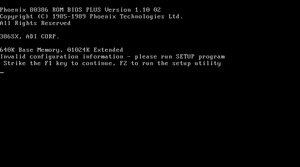
Phoenix ROM BIOS PLUS is a version of PhoenixBIOS released in 1987 by Phoenix Technologies. It is based on the classic PhoenixBIOS codebase. It is also the first version of PhoenixBIOS to include a built-in CMOS setup utility, although this is not present in all instances. It also introduced minor changes with some POST messages and a more detailed memory test (listing both base and extended memory).
It was succeeded by PhoenixBIOS 4.0x (based on the Quadtel BIOS codebase) in 1988 and PhoenixBIOS Ax86 (based on the classic PhoenixBIOS codebase) in circa 1990-1991.
Built-in CMOS setup utility
Initially, Phoenix only offered a single default option for the CMOS setup utility. This option had two color variants: Cyan/blue and black/cyan. Other than the color scheme and some other cosmetic changes, both of these variants are functionally the same.
On later instances, the PhoenixBIOS Ax86 setup utility could also be seen, which is both visually and functionally different from the earlier utilities. However it is unknown if this was an official option that was later available from Phoenix or the result of an unofficial OEM modification performed by porting the Ax86 setup utility to the older ROM BIOS PLUS codebase.
On all setup utilities, when entering the setup utility after an error has occurred during POST, a brief error log is displayed containing a list of all the errors that have occurred. This screen can be skipped by pressing any key on the keyboard.
-
Error log screen for setup variant 1
-
Setup screen (variant 1)
-
Error log screen for setup variant 2
-
Setup screen (variant 2, top text modified by Samsung although the utility is from Phoenix)
Dell version
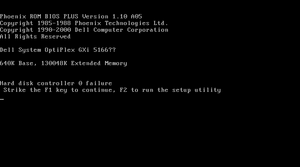
Dell used to develop their own version of the Phoenix ROM BIOS PLUS, which they began developing in 1990 by creating a fork based on the 1988 code base. This version was used on many newer Dell computers, with the last known instance of it being released in February 2020 as a BIOS update for the PowerEdge R620, which was originally released in 2012, making it one of the last computers ever to use this BIOS.
Over its lifetime, Dell has added many new features to this fork that the original ROM BIOS PLUS never had, such as Plug and Play (PnP) support, automatic storage drive detection, SATA drive support, silent boot (full-screen BIOS logo that hides messages during POST), hardware monitoring for fan speed and temperature sensors, and more. Very late instances of this version (specifically on the latest PowerEdge series of servers that use it) even support UEFI, likely with a custom add-on written to provide an appropriate API for the features needed for UEFI support. However, it is not known if this was developed solely by Dell, or if it is fully or at least partially based on a solution from Phoenix or another vendor, as UEFI is a fundamentally different standard from BIOS. In addition to new features, several custom setup utilities have been created for this version over its lifetime, as shown below.
Although this version was originally based on the standard 1988 Phoenix ROM BIOS PLUS codebase, it has evolved into a distinctly different solution due to Dell's many changes and new features, and therefore cannot be considered the same as the original version it was based on.
-
Silent boot (full-screen boot logo) on OptiPlex GX150
-
Setup utility variant 1 (1990 - mid 2000s), as seen on the OptiPlex GXi 5166
-
Setup utility variant 2 (late 1990s - 2020), as seen on the OptiPlex GX150
-
Setup utility variant 3 (early 2000s - late 2000s) as seen on the Dell Latitude D630
-
Setup utility variant 4 (late 2000s - early 2010s) as seen on the Dell Precision T3500

